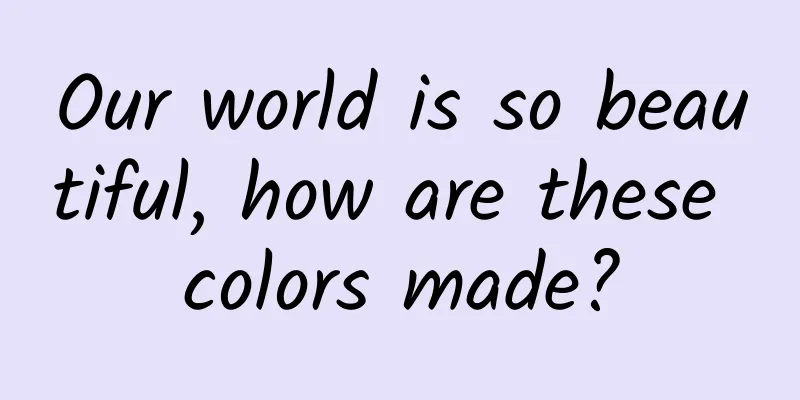Our world is so beautiful, how are these colors made?

|
Light brings brightness to the world. Humans and many animals, because they have eyes that allow them to receive and feel light, are able to understand the world and enjoy the beauty of spring, summer, autumn and winter. Without light, the world would be dark and people would not be able to see anything. But with light, the world is colorful. Some people may think that the world is colorful and light just illuminates it. In fact, the world is colorless. It is light that gives the world color. In fact, in addition to matter, this world is also full of energy. Electromagnetic waves are the main way of energy transmission in our world, and the transmission medium is photons. Therefore, electromagnetic waves can also be called light waves. Light waves can be divided into many types in different bands and frequencies, mainly radio waves (including long waves, medium waves, short waves, microwaves), infrared rays, visible light, ultraviolet rays, X-rays, and gamma rays. Except for visible light, the rest of the light waves are invisible, but they can be made visible with the corresponding instruments. Radio and various ray telescopes can see or receive these invisible light waves. The wavelength of electromagnetic waves ranges from kilometers to atm (1 atm = 10^-18 meters). Generally speaking, the wavelength of radio waves ranges from 3000 meters or longer to 0.1 mm; the wavelength of infrared waves ranges from 0.1 mm to 760 nanometers; the wavelength of visible light ranges from 760 nanometers to 380 nanometers; the wavelength of ultraviolet rays ranges from 380 nanometers to 10 nanometers; the wavelength of X-rays ranges from 10 nanometers to 1 picometer; the wavelength of gamma rays is less than 10^-12 meters, and the wavelength of the highest energy gamma rays can be as short as 10^-30 meters! The shorter the wavelength of light waves, the higher the frequency and the higher the energy. Light waves with wavelengths shorter than visible light have higher frequencies and therefore greater energy. For example, ultraviolet rays, X-rays, and gamma rays are lethal to organisms and humans, especially X-rays and gamma rays, which can kill people if exposed to excessive amounts. The relationship between wavelength and frequency follows the formula: c=λf or λ=c/f or f=c/λ. Here c is the speed of light, λ is the wavelength, and f is the frequency. What the human eye can see is visible light. Visible light is a composite light, not colorless. It is generally divided into seven colors: red, orange, yellow, green, cyan, blue, and violet. The wavelength gradually shortens from 760 nanometers to 380 nanometers. Therefore, red light has the lowest energy and violet light has the highest energy. Sunlight is such a composite light. Through a prism, these different colors of light can be dispersed by refraction, which is called dispersion. Generally speaking, the wavelength range of the seven colors of light is approximately: red light 760~622 nanometers; orange light 621~597 nanometers; yellow light 596~577 nanometers; green light 576~492 nanometers; cyan light 491~450 nanometers; blue light 449~435 nanometers; and purple light 434~380 nanometers. Strictly speaking, there is no clear dividing line between these seven colors. They are gradual, from 760 nanometers of red light to 380 nanometers of purple light. If the wavelength is shorter, it becomes ultraviolet light, which is invisible to the human eye. The wavelengths of different colors are only relative and are only for the convenience of explanation. There is no strict and accurate boundary. Therefore, when describing the wavelengths of different colors of light, the data of various materials are not exactly the same. Since visible light has so many colors, theoretically countless colors can be mixed by combining different colors in different proportions. The bizarre colors of this world are mixed by visible light. How does visible light adjust the color of the world? Our world is made up of all kinds of strange-shaped substances, which have the functions of absorbing light, reflecting, refracting and scattering. Different substances have different absorption rates for light of different wavelengths, and the reflection, refraction and scattering methods and proportions are also different. In this way, the absorbed light cannot be seen by the human eye, while the non-absorbed light can be seen by the human eye, and different objects appear in different colors. For example, if an object mainly absorbs red light of around 700 nanometers, the reflected light seen by the human eye is green; if it mainly absorbs cyan light of around 500 nanometers, the reflected light seen by the human eye is red. So, why do the same materials, such as bricks, iron blocks, stones, sand, etc., not blur and still be distinguished by the human eye? This is because these objects are only roughly the same, with slightly different shapes, not perfectly identical, and different positions and angles. In this way, although they absorb and reflect light at roughly the same wavelength, the amount of absorption and reflection will be different, so the colors seen by the human eye are different. For example, the leaves of the same tree absorb and reflect light at similar wavelengths, so the leaves we see are generally green. However, each leaf has a different shape, size, and orientation toward the light source, so the leaves we see are bright and dark, and the colors are not exactly the same, creating a sense of layering. In theory, when we see an object of a certain color, it is because the object is repelling that color and reflects the light of that color back, while the light absorbed is the color that the human eye cannot see, that is, the light of the complementary wavelength to the color seen. If an object reflects all light or absorbs all light, what we see is white or black. Can white and black absolutely reflect and absorb light? Since light has color, what would happen if some objects in this world do not absorb any light, or absorb all light? These are theoretical white bodies and black bodies. The reflectivity ρ of an object indicates the object's ability to prevent radiation. The so-called white body has a reflectivity of ρ=1 for light, and people see this kind of object as pure white; the opposite is a black body, which has an absorption rate of α=1 for light radiation, that is, it does not reject light and absorbs all light. The so-called white body and black body absorb and reflect not only visible light, but all electromagnetic radiation, including all absorption or reflection of radio, infrared, visible light, ultraviolet, X-rays, and gamma rays. Only then can they be called white body and black body, also called absolute white body and absolute black body. There are no truly perfect white bodies or black bodies in the real world, only approximations. White snow is a white body for visible light, because the reflectivity of unpolluted white snow for visible light is close to ρ=1, so it appears pure white to the human eye. But white snow has no resistance to infrared light at all, and its absorption is almost α=1, so it is a black body relative to infrared light. Professor Ruan Xiulin's team at Purdue University in the United States has invented an ultra-white paint that reflects 98.1% of sunlight, while the reflectivity of white paint on the market is only 90%. This barium sulfate ultra-white paint that can radiate cooling has become the whitest paint in the Guinness Book of World Records. Objects covered with this paint can be cooled by up to 11°C below ambient temperature. Ruan Xiulin said in an interview with the media that if a 1,000-square-foot roof is covered with super white paint, it is estimated that 10 kilowatts of cooling power can be obtained, which is more powerful than using central air conditioning. It can be seen that white body not only looks white, but is also the best technology for energy conservation and emission reduction. Surrey Nanotech in the UK has developed a material called Vantablack. When this material is applied to a statue, the human eye can no longer see the three-dimensional details of the statue, but only a black plane, which cannot be illuminated even with strong light. It is said that this material can absorb 99.96% of the incident light, which means that its reflectivity is only 0.04%, so it is called a black body. Therefore, if all matter in this world is composed of white bodies or black bodies, our human eyes can only see a black and white world. In addition, the human eye and brain have evolved over a long period of time under the light environment, so they have the ability to sense various colors. If there is a problem with the photoreceptor cells, color blindness symptoms will occur, and the ability to distinguish certain colors will be lost, or only a gray and white world can be seen. That’s all for today, thank you for reading and welcome to discuss. The copyright of Space-Time Communication is original. Infringement and plagiarism are unethical behavior. Please understand and cooperate. |
>>: Straight man’s insights: Why is my wife not afraid of boiling water?
Recommend
Toutiao: We aim to earn 6 billion from advertising this year and make the data transparent!
It is said that the second floor of the new offic...
Liu Zhanwen | Standing tall and shouldering the mission of intelligent transportation Fu Fanghua
As a female young scientist born in the 1980s who...
Advertising strategies for 8 popular industries including education, home decoration, wedding photography, and tourism
In the blink of an eye, 2019 has come to an end. ...
Apple will release Swift 3.0 and announce the development content of the fourth version
Although the official version of Swift 3.0 will b...
Case analysis: How are promotional marketing activities planned and implemented?
Next, let’s talk about the design forms of market...
“Ruthenium signature” confirms: Did the great destruction 66 million years ago come from the outer solar system?
For a long time, the sudden disappearance of dino...
Cartoon丨Why was perennial rice selected as one of Science’s “Top Ten Scientific Breakthroughs of 2022”?
Who says rice is only grown annually? Now there i...
10 insights behind the 120,000 yuan marketing campaign
Holiday campaigns have always been the focus of b...
5 practical typography tips to improve the high-end feel of UI interface
In the UI interface, typography design is equally...
How to promote APP on campus by doing activities
1. There are three common activities: booth activ...
How do internet celebrity brands commit suicide?
Wherever there is the Internet, there are Interne...
Say goodbye to information asymmetry and restore the true truth about mobile phone repairs!
Some time ago, Ms. Wang from Wuhan repaired her m...
Short Video Academy·Director Shooting and Editing Core Course, master the two practical skills and underlying thinking necessary for video creation
Short Video Academy·Director Shooting and Editing...
Electric Technology Car News: If you only know how to step on the accelerator when overtaking, you are wrong. Only by learning these few skills can you become an experienced driver.
Whether it is daily driving or on the highway, ov...
Blanching is not just boiling! These 6 types of food must be blanched, but you may not have blanched them correctly...
Blanching is a common cooking process, but do you...









